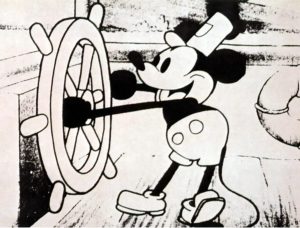 On January 1, 2024, a significant shift in intellectual property rights occurred with the iconic American pop culture figure, Mickey Mouse, entering the public domain. The copyright for Mickey’s debut appearance in the 1928 short film, “Steamboat Willie,” finally expired, allowing a specific portrayal of the beloved character to become available for public use.
On January 1, 2024, a significant shift in intellectual property rights occurred with the iconic American pop culture figure, Mickey Mouse, entering the public domain. The copyright for Mickey’s debut appearance in the 1928 short film, “Steamboat Willie,” finally expired, allowing a specific portrayal of the beloved character to become available for public use.
This momentous occasion follows a prolonged journey shaped by numerous extensions and revisions of copyright laws. Under U.S. copyright law, which typically spans 95 years, the extension became colloquially known as the “Mickey Mouse Protection Act.” This extension, sought not only by Disney but also by a coalition of copyright holders, aimed to safeguard their works for an extended period.
Jennifer Jenkins, a law professor and director of Duke’s Center for the Study of Public Domain, compared this milestone to the puff of smoke from a steamboat, expressing her enthusiasm at the symbolic moment.
However, it’s crucial to acknowledge the nuanced aspects of this development. The specific depiction of Mickey Mouse as a mischievous, non-speaking boat captain in “Steamboat Willie” now resides in the public domain. Nevertheless, Disney still maintains control over newer iterations of the character, solidifying its status as a global ambassador in various media and merchandise.
The distinction between what falls within Disney’s copyright and what enters the public domain presents an intriguing challenge. Not every characteristic or trait of a character may be copyrightable, potentially leading to legal disputes in the future.
While Disney acknowledges the expiration of the “Steamboat Willie” copyright, the company remains steadfast in protecting the rights to newer iterations of Mickey Mouse and other copyrighted works. This differentiation extends to their trademark ownership, preventing misleading usage that might confuse consumers regarding the original creator of a product.
Aside from Mickey Mouse, other notable works like Tigger from “The House at Pooh Corner” and creations by renowned artists such as Charlie Chaplin, Virginia Woolf, and Bertolt Brecht will also enter the public domain. However, differences in copyright terms between nations create delays in some works entering the public domain in the U.S. compared to their country of origin.
This shift holds implications beyond Mickey Mouse, sparking broader discussions about copyright duration and the potential loss of creative works within intricate copyright frameworks.
As the public domain expands, attention turns to how creators and audiences will shape the narrative around these newly liberated works. Advocates like Cory Doctorow emphasize the role of the audience in determining the future utilization of these properties.
The journey leading to Mickey Mouse’s partial entry into the public domain highlights the complexities and debates within copyright law, emphasizing the need for a balance between protecting intellectual property and encouraging creative innovation.
January 1, 2024, signifies not just a legal milestone but prompts contemplation about the cultural significance of these cherished characters and works as they step into the realm of shared ownership and creative exploration.
- SEO Powered Content & PR Distribution. Get Amplified Today.
- PlatoData.Network Vertical Generative Ai. Empower Yourself. Access Here.
- PlatoAiStream. Web3 Intelligence. Knowledge Amplified. Access Here.
- PlatoESG. Carbon, CleanTech, Energy, Environment, Solar, Waste Management. Access Here.
- PlatoHealth. Biotech and Clinical Trials Intelligence. Access Here.
- Source: https://www.iniplaw.org/charting-new-waters-steamboat-willies-mickey-mouse-sets-sail-into-the-public-domain/
- :not
- 1
- 2024
- a
- About
- acknowledge
- Act
- advocates
- aimed
- Allowing
- also
- Ambassador
- American
- an
- and
- around
- Artists
- AS
- aspects
- At
- attention
- audience
- audiences
- available
- Balance
- BE
- became
- become
- beloved
- between
- Beyond
- boat
- broader
- but
- by
- Center
- challenge
- character
- characteristic
- characters
- Charlie
- charting
- coalition
- company
- compared
- complexities
- Consumers
- control
- copyright
- country
- create
- creations
- Creative
- creator
- creators
- crucial
- cultural
- Culture
- debates
- debut
- delays
- determining
- Development
- differences
- Director
- discussions
- Disney
- disputes
- distinction
- domain
- duration
- emphasize
- emphasizing
- encouraging
- Enter
- entering
- Enters
- enthusiasm
- entry
- Every
- expands
- expiration
- exploration
- expressing
- extended
- extends
- extension
- extensions
- Falls
- Figure
- Film
- Finally
- follows
- For
- frameworks
- from
- future
- Global
- her
- highlights
- holders
- holds
- House
- How
- However
- HTTPS
- iconic
- implications
- in
- Innovation
- intellectual
- intellectual property
- into
- intricate
- intriguing
- iterations
- ITS
- January
- journey
- jpg
- just
- known
- Law
- Laws
- leading
- Legal
- like
- loss
- maintains
- max-width
- May..
- Media
- merchandise
- might
- milestone
- misleading
- moment
- momentous
- mouse
- NARRATIVE
- Nations
- Need
- Nevertheless
- New
- newer
- newly
- notable
- now
- numerous
- occasion
- occurred
- of
- only
- or
- Origin
- original
- Other
- over
- ownership
- period
- plato
- Plato Data Intelligence
- PlatoData
- pop
- Pop Culture
- potential
- potentially
- presents
- preventing
- Product
- Professor
- prompts
- properties
- property
- Property Rights
- protecting
- protection
- public
- realm
- regarding
- remains
- Renowned
- revisions
- rights
- Role
- s
- Sets
- Shape
- shaped
- shared
- shift
- Short
- significance
- significant
- signifies
- Smoke
- solidifying
- some
- sought
- spans
- specific
- Status
- steadfast
- Step
- Still
- Study
- such
- symbolic
- terms
- that
- The
- The Future
- their
- These
- they
- this
- to
- trademark
- turns
- typically
- u.s.
- under
- Usage
- use
- various
- virginia
- Waters
- What
- which
- will
- with
- within
- works
- years
- zephyrnet











